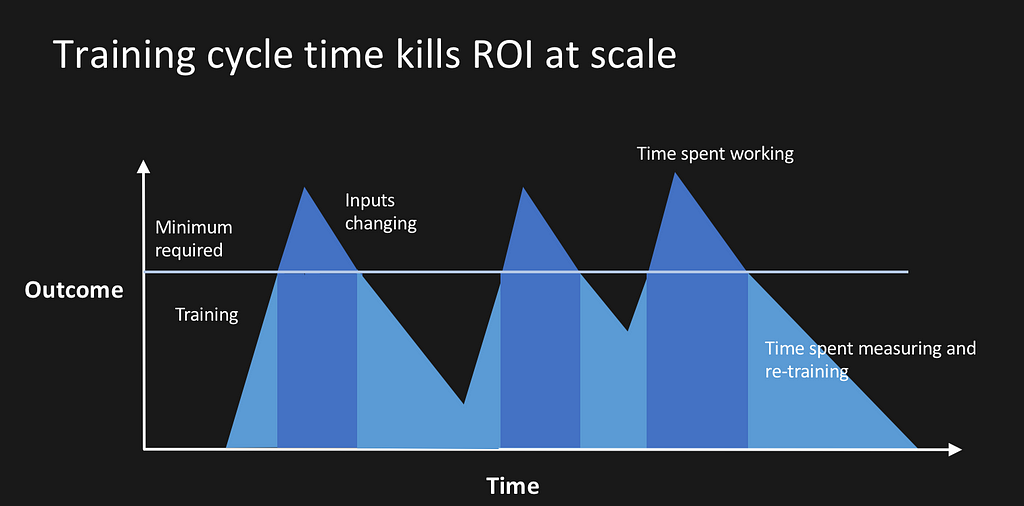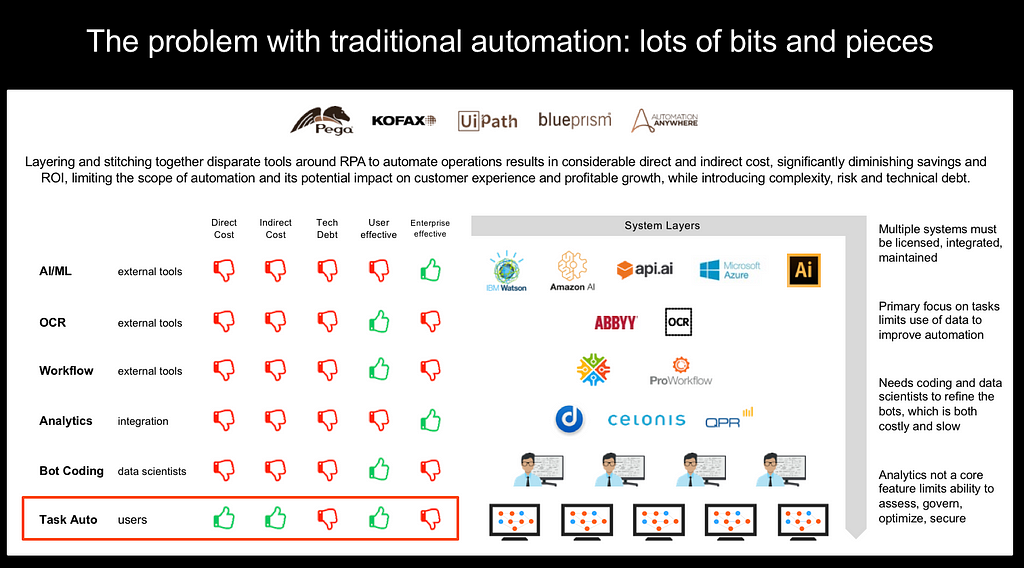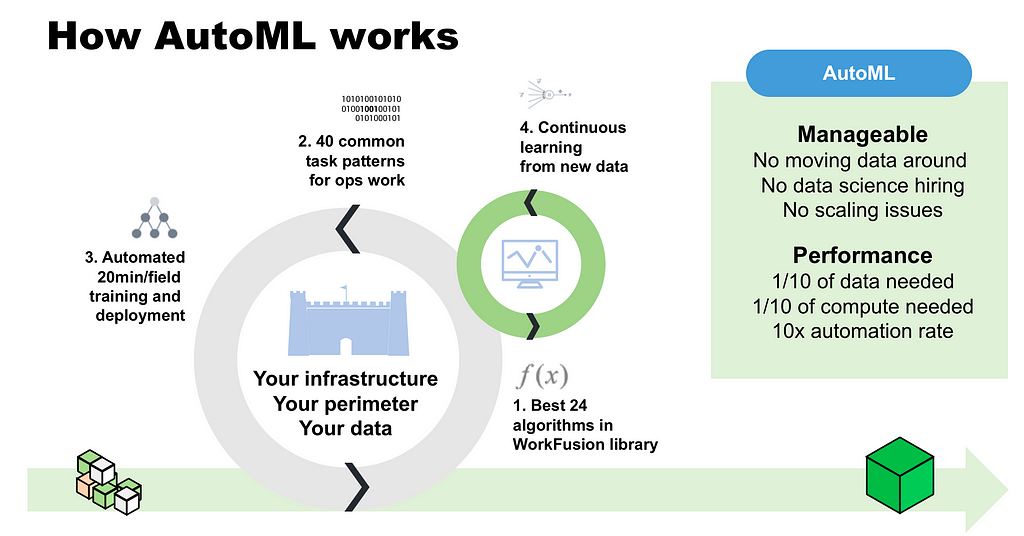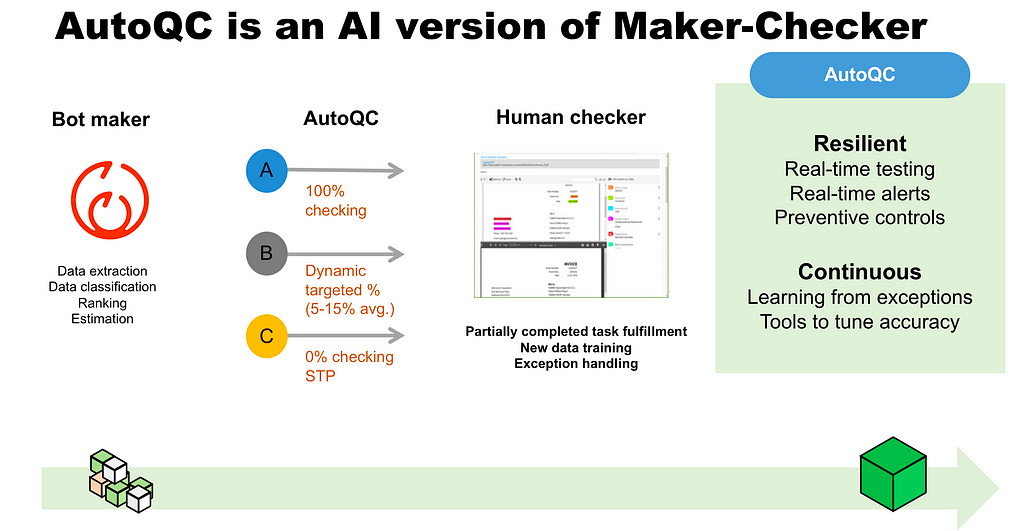Robot
BLEEP, BLIP, BLOOP
In an industry growing and changing as fast as business process automation, how do you know what technology developments are important, and how can you tell how those developments will impact your business? We tackle this topic periodically in our State of Intelligent Automation webinar series. In our Fall 2018 edition, WorkFusion Chief Evangelist Adam Devine made clear what the single most important capability is in process automation right now: software robots that learn from and adapt to real-time data.
You can freely watch that webinar on-demand to learn more about learning bots, the importance of a single platform, predictive analytics and what capabilities it takes to achieve digital operations on-demand.
What follows is both a recap of the key points within the webinar and the answers to the most popular questions asked by our live audience.
Are we in an RPA bubble? Maybe. The recent Wall Street Journal article suggests we are. Forrester analyst Craig Le Clair doesn’t believe the valuations of the top three “RPA 1.0” companies are justified, and Hacket Group VP of Research Erik Dorr observes in the article that there’s “no real software magic” behind RPA 1.0 products.
What does this mean?
It means that the first generation of RPA product use rules-based software to automate predictable functions that involve structured, static data through application user interfaces. Given that, according to Gartner, 80% of data within a typical enterprise is unstructured, this limits the application of RPA 1.0 within typical customer environments. McKinsey further reports that one third of automation use cases change monthly, and one quarter change daily. RPA software that lacks the ability to dynamically learn from and adapt to changing processes and inputs will require constant training, and any reduction in manual work will be lost in people retraining bots.

First generation RPA vendors overpromised and over-marketed their products with the “scent of AI.” UI Path CEO Daniel Dines went so far in the WSJ article to say that, “AI makes it sexier for companies to think about automation.” It’s time for the market to understand what’s real and what’s froth.
2. The mandate for AI-driven automation
AI-driven automation delivers what RPA 1.0 companies have promised. As Craig Le Clair explains in the WSJ article, “higher-order artificial intelligence software can learn when presented with new data and make decisions without human input, such as monitoring credit card charges for fraud, or determining whether to underwrite an insurance policy.” Software robots that learn through AI are able to adapt to the frequent change in both processes and inputs, maintain optimal levels of automation, and deliver sustainable reductions in manual effort for customers.
One of the most important concepts in the webinar is the evolution from “Software 1.0” to “Software 2.0.”
Software 1.0, which has been the programming paradigm since computers were invented, requires programmers to decompose a problem into steps, write rules for each step of the problem, compose each rule into a system and then measure performance. When performance suffers as a result of change, programmers edit the code. This is precisely how RPA works: people train bots, data and rules change, people retrain bots. Rinse and repeat.
AI-driven automation flips the paradigm by using dynamic data within a process to automatically train machine learning (ML) algorithms, which people validate through simple user interfaces. Once the ML achieves an optimal level of completeness and accuracy, people are engaged only to handle exceptions, which make the learning bots incrementally smarter. This constant learning means that customers achieve higher levels of automation over time without the need for data scientists or programmers. It means that AI becomes a truly self-service capability for business people.

Rules-based RPA serves an important role in process automation in that it pulls from applications the data that AI needs to learn from and then pushes structured data into systems that execute commands based on this data, but RPA is only one of many capabilities, all subservient to AI, that companies need to automate an entire end-to-end process.
What it takes to get to Digital Operations
Digital Operations is the promised land for enterprise businesses. Digital Operations means that the slick digital interfaces and chatbots that customer engage with in the front office of a business are paired with intelligent automation in the middle and back office of a business to ensure that services — like customer onboarding in banking and claims handling in insurance — are fast, frictionless and accurate for both the business and its customers.
To achieve Digital Operations, customers need:
The impact of AI-driven automation compared to rules-based RPA is apparent at a single process level and becomes even more apparent with attempts to scale across a business: RPA 1.0 hits a wall after “a few bots,” which AI-driven automation scales quickly, efficiently and with significant ROI.

Top questions asked by our live audience
Our live audience joined the webinar from all over the world and ranged from customers to prospects to partners, and from COOs of enterprise companies who have scaled our flagship product, Smart Process Automation, to single users of our popular free RPA product, RPA Express.
Most of the questions fell into the following categories:
1. How machine learning works and how it trains
2. Data ingestion and optical character recognition (OCR)
3. Automation control
4. Hardware and infrastructure
Given how core it is to WorkFusion’s AI-driven model, let’s start with how ML works and how it learns.

It’s fairly easy to grasp the concept of rules-based RPA. A person clicks and drags on a screen, RPA records actions and repeats them either when a person executes the function or when when cued by an event, like incoming data. Whereas traditional RPA products only follow rules, WorkFusion SPA includes rules-based RPA to “pull” and “push” data but also learns from and adapts to this data through AI to automate unstructured work.
Because it’s newer technology, no other RPA software provider delivers it as a native capability, and cloud-based AI providers make it complex (and expensive) for businesses to use, understanding AI is a little more though-provoking. Our live webinar audience asked the following AI-related questions:
WorkFusion SPA includes a native capability called AutoML that automates the data cleansing, model selection and model training work typically done manually by data scientists. The software includes an interface that business people use to tag unstructured data so that ML models can identify patterns in work. Once it has seen enough examples of work patterns, the software predicts with human or better level of confidence how work should be performed. AutoML significantly reduces the amount of time and cost it takes to deploy and scale AI by making it a scalable self-service capability for business people.

AutoML can learn not only from Word documents, PDFs and TIFFs but also spreadsheets, emails, text messages, webpages, and comments fields. SPA is unique in the AI arena in that, rather than requiring millions of samples like popular cloud-based AI providers, it can optimally train on 300 to 500 samples before delivering an impactful rate of automation. Each additional sample incrementally increases the automation rate.
Many automation use cases across a business have the same tasks. For example, in banking, a mortgage document and a SWIFT message are different forms of data and are used in different processes, but they both include people’s names and addresses. Transfer Learning, a native feature of WorkFusion SPA, applies learning from one use case to another use case with the same task. This reduces the amount of time it takes ML to learn and deploy.
All of the features covered in the webinar are native to WorkFusion SPA and included in the product from day one. WorkFusion SPA is the most advanced, complete automation product on the market and has been chosen as the tip of the transformation spear by the world’s biggest banks, insurance companies and healthcare organizations.
2. Data ingestion and optical character recognition (OCR)
Most business processes require the ingestion of data, and much of this data comes in the form of image-based files, like PDFs. OCR digitizes information so that it can be extracted by ML. Audience members asked the following questions about OCR.
OCR as a stand-alone point solution needs a mechanism for moving data into it, and it must be configured for each new template. OCR as an integrated capability within WorkFusion SPA uses RPA to move data into the native OCR engine. WorkFusion’s OCR capability doesn’t require configuration on each new template. It instead focuses on the content within a template, which means that the thousands of different formats of invoices in a typical enterprise accounts payable process seamlessly pass through RPA, OCR and ML without the need for constant configuration and maintenance.
While many OCR products make extraction and classification packages available as additions to core digitization capabilities, OCR underperforms in accuracy and completeness compared to ML-driven software bots. Customers achieve significantly faster transaction times, higher automation rates and greater accuracy with the native pairing of RPA, OCR and ML in processes that involve image-based data.
Traditional pipelined OCR is indeed slow. Like rules-based code, most OCR consists of modules that ‘binarize’ inputs sequentially into sentences, words and characters. Machine learning-based image digitization is often superior to traditional pipelined OCR because, instead of the more time-consuming, sequential recognition of each character, it learns content through data. This increases the automation rate within OCR and significantly accelerates the extraction and classification of all content, including emails. WorkFusion SPA uses both traditional pipelined OCR and ML-based digitization and calibrates the digitization technique based on the content.
3. Automation Control
Automation is the new superpower for enterprise operations. As such, everyone wants bots. Being able to centralize the control, performance and monitoring of software robots is critical for ensuring compliance, assessing ROI and planning operational budgets and capacity. Audience members asked the following questions about automation control:
Everything that a person is capable of doing is either based on direct experience (i.e., learning) or inference. Here’s how this plays out in our minds: “have I seen this task before, or is this task similar to another task I’ve completed? If neither is true, I’ll ask for help.” AI works in a similar way, and WorkFusion has patented and packaged the quality control of enterprise knowledge work into a native capability called AutoQC.
If the patterns of new content or a change in a process can be identified based on learning or inference, WorkFusion SPA’s accuracy is superior to that of a person. If the SPA’s models cannot recognize or infer a pattern in the data, AutoQC automatically escalates the task to a person for validation and uses this human validation as new training for ML model. This integral combination of ML and people and automated escalation ensures the accuracy of all work performed by WorkFusion SPA. Users can either rely on WorkFusion SPA to optimally balance accuracy and efficiency or set a minimum accuracy confidence level.

Compliance is a critical component to successfully scaling automation, particularly in regulated industries such as financial services and healthcare. WorkFusion SPA makes it easy to ensure compliance by providing an audit trail for every task: “who touched what, and when?” WorkFusion SPA also provides what is sometimes referred to as algorithm forensics or explainable AI. This means that customers and outside regulators alike can unwind how an algorithm made a decision, showing each data and decision point.
By mastering programmatic quality control of both bot and human work, WorkFusion SPA is actually able to optimally manage large teams of people. The software is able assess the capacity and capability of human workers and delegate appropriate tasks to individuals. This capability is critical for handling bot exceptions, and it adds great value to businesses that have large, distributed workforces.
4. Hardware and infrastructure requirements
AI has historically been exceptionally expensive due computing and hardware requirements, but AI is quickly becoming an essential building block for business success. The stock prices of companies (like Nvidia) that provide graphics processing units (GPU), which are chips specially designed to handle large batches of data and perform operations rapidly and repetitively, have consequently surged. Prospective customers therefore sometimes wonder if WorkFusion SPA is more expensive to operate than traditional, rules-based RPA. WorkFusion SPA requires no special hardware and is exceptionally efficient both on-premise and in the cloud, delivering the lowest total cost of ownership of any process automation software on the market. Audience members asked the following questions about hardware and infrastructure:
WorkFusion SPA can run on-premise, in the cloud or in a hybrid on-premise / cloud model. The product is built for typical enterprise environments, infrastructure and data. WorkFusion SPA requires only a cluster of regular servers without complex requirements like GPUs or custom chips.
Data and models are the property of our customers. While we have some customers with whom we have closely collaborated and thus have unique Intellectual Property (IP) agreements to share assets, our typical software license gives ownership of both data and models trained using customer data to customers.
<><><>
Like data and business processes, automation technology is in a constant state of evolution and change. Customers choose WorkFusion because we, as a company, are relentlessly committed to staying ahead of change. Enterprise businesses with aggressive digital agendas choose WorkFusion as their long-term automation partner because our products are conceived by looking further into the future than our competitors, by anticipating what our customers will need in the future, and by creating trends rather than following them.
We welcome your questions about how our products can help you solve operational problems, create new revenue, and outpace your competition at learn@workfusion.com

The State of Intelligent Automation, Fall 2018 was originally published in WorkFusion on Medium, where people are continuing the conversation by highlighting and responding to this story.
Continue reading...
You can freely watch that webinar on-demand to learn more about learning bots, the importance of a single platform, predictive analytics and what capabilities it takes to achieve digital operations on-demand.
What follows is both a recap of the key points within the webinar and the answers to the most popular questions asked by our live audience.
- Cutting through RPA froth
Are we in an RPA bubble? Maybe. The recent Wall Street Journal article suggests we are. Forrester analyst Craig Le Clair doesn’t believe the valuations of the top three “RPA 1.0” companies are justified, and Hacket Group VP of Research Erik Dorr observes in the article that there’s “no real software magic” behind RPA 1.0 products.
What does this mean?
It means that the first generation of RPA product use rules-based software to automate predictable functions that involve structured, static data through application user interfaces. Given that, according to Gartner, 80% of data within a typical enterprise is unstructured, this limits the application of RPA 1.0 within typical customer environments. McKinsey further reports that one third of automation use cases change monthly, and one quarter change daily. RPA software that lacks the ability to dynamically learn from and adapt to changing processes and inputs will require constant training, and any reduction in manual work will be lost in people retraining bots.

First generation RPA vendors overpromised and over-marketed their products with the “scent of AI.” UI Path CEO Daniel Dines went so far in the WSJ article to say that, “AI makes it sexier for companies to think about automation.” It’s time for the market to understand what’s real and what’s froth.
2. The mandate for AI-driven automation
AI-driven automation delivers what RPA 1.0 companies have promised. As Craig Le Clair explains in the WSJ article, “higher-order artificial intelligence software can learn when presented with new data and make decisions without human input, such as monitoring credit card charges for fraud, or determining whether to underwrite an insurance policy.” Software robots that learn through AI are able to adapt to the frequent change in both processes and inputs, maintain optimal levels of automation, and deliver sustainable reductions in manual effort for customers.
One of the most important concepts in the webinar is the evolution from “Software 1.0” to “Software 2.0.”
Software 1.0, which has been the programming paradigm since computers were invented, requires programmers to decompose a problem into steps, write rules for each step of the problem, compose each rule into a system and then measure performance. When performance suffers as a result of change, programmers edit the code. This is precisely how RPA works: people train bots, data and rules change, people retrain bots. Rinse and repeat.
AI-driven automation flips the paradigm by using dynamic data within a process to automatically train machine learning (ML) algorithms, which people validate through simple user interfaces. Once the ML achieves an optimal level of completeness and accuracy, people are engaged only to handle exceptions, which make the learning bots incrementally smarter. This constant learning means that customers achieve higher levels of automation over time without the need for data scientists or programmers. It means that AI becomes a truly self-service capability for business people.

Rules-based RPA serves an important role in process automation in that it pulls from applications the data that AI needs to learn from and then pushes structured data into systems that execute commands based on this data, but RPA is only one of many capabilities, all subservient to AI, that companies need to automate an entire end-to-end process.
What it takes to get to Digital Operations
Digital Operations is the promised land for enterprise businesses. Digital Operations means that the slick digital interfaces and chatbots that customer engage with in the front office of a business are paired with intelligent automation in the middle and back office of a business to ensure that services — like customer onboarding in banking and claims handling in insurance — are fast, frictionless and accurate for both the business and its customers.
To achieve Digital Operations, customers need:
- a single AI-native platform with all critical automation capabilities built-in to avoid costly integration projects and ensure the security of sensitive data,
- predictive automation analytics to see not only how automation has performed but also how it will perform and how to optimize it,
- preemptive controls to avoid “rogue bots” and provide risk control for automation
- plug-and-play scalability to deploy automation across business units, functions and geographies, and
- centralized governance to bring existing workforce and operations governance protocols into automation.
The impact of AI-driven automation compared to rules-based RPA is apparent at a single process level and becomes even more apparent with attempts to scale across a business: RPA 1.0 hits a wall after “a few bots,” which AI-driven automation scales quickly, efficiently and with significant ROI.

Top questions asked by our live audience
Our live audience joined the webinar from all over the world and ranged from customers to prospects to partners, and from COOs of enterprise companies who have scaled our flagship product, Smart Process Automation, to single users of our popular free RPA product, RPA Express.
Most of the questions fell into the following categories:
1. How machine learning works and how it trains
2. Data ingestion and optical character recognition (OCR)
3. Automation control
4. Hardware and infrastructure
Given how core it is to WorkFusion’s AI-driven model, let’s start with how ML works and how it learns.

- How machine learning works and how it trains
It’s fairly easy to grasp the concept of rules-based RPA. A person clicks and drags on a screen, RPA records actions and repeats them either when a person executes the function or when when cued by an event, like incoming data. Whereas traditional RPA products only follow rules, WorkFusion SPA includes rules-based RPA to “pull” and “push” data but also learns from and adapts to this data through AI to automate unstructured work.
Because it’s newer technology, no other RPA software provider delivers it as a native capability, and cloud-based AI providers make it complex (and expensive) for businesses to use, understanding AI is a little more though-provoking. Our live webinar audience asked the following AI-related questions:
- How does WorkFusion SPA learn user actions automatically?
- Are documents the only input accepted by AutoML? Is there any other way to train using more unstructured data?
- What is the size of the sample set required to auto train the ML?
- How does AutoML leverage what it learned in different scenarios?
- Does WorkFusion already include all the AI features you described?
WorkFusion SPA includes a native capability called AutoML that automates the data cleansing, model selection and model training work typically done manually by data scientists. The software includes an interface that business people use to tag unstructured data so that ML models can identify patterns in work. Once it has seen enough examples of work patterns, the software predicts with human or better level of confidence how work should be performed. AutoML significantly reduces the amount of time and cost it takes to deploy and scale AI by making it a scalable self-service capability for business people.

AutoML can learn not only from Word documents, PDFs and TIFFs but also spreadsheets, emails, text messages, webpages, and comments fields. SPA is unique in the AI arena in that, rather than requiring millions of samples like popular cloud-based AI providers, it can optimally train on 300 to 500 samples before delivering an impactful rate of automation. Each additional sample incrementally increases the automation rate.
Many automation use cases across a business have the same tasks. For example, in banking, a mortgage document and a SWIFT message are different forms of data and are used in different processes, but they both include people’s names and addresses. Transfer Learning, a native feature of WorkFusion SPA, applies learning from one use case to another use case with the same task. This reduces the amount of time it takes ML to learn and deploy.
All of the features covered in the webinar are native to WorkFusion SPA and included in the product from day one. WorkFusion SPA is the most advanced, complete automation product on the market and has been chosen as the tip of the transformation spear by the world’s biggest banks, insurance companies and healthcare organizations.
2. Data ingestion and optical character recognition (OCR)
Most business processes require the ingestion of data, and much of this data comes in the form of image-based files, like PDFs. OCR digitizes information so that it can be extracted by ML. Audience members asked the following questions about OCR.
- Kofax and other tools like Captiva also provide ML based OCR data extraction and classification. Why do I need WorkFusion SPA?
- We have tried to deploy OCR for extracting, classifying emails, but noticed that the OCR takes a long time to finish. Can AI recognition be used instead of traditional OCR?
OCR as a stand-alone point solution needs a mechanism for moving data into it, and it must be configured for each new template. OCR as an integrated capability within WorkFusion SPA uses RPA to move data into the native OCR engine. WorkFusion’s OCR capability doesn’t require configuration on each new template. It instead focuses on the content within a template, which means that the thousands of different formats of invoices in a typical enterprise accounts payable process seamlessly pass through RPA, OCR and ML without the need for constant configuration and maintenance.
While many OCR products make extraction and classification packages available as additions to core digitization capabilities, OCR underperforms in accuracy and completeness compared to ML-driven software bots. Customers achieve significantly faster transaction times, higher automation rates and greater accuracy with the native pairing of RPA, OCR and ML in processes that involve image-based data.
Traditional pipelined OCR is indeed slow. Like rules-based code, most OCR consists of modules that ‘binarize’ inputs sequentially into sentences, words and characters. Machine learning-based image digitization is often superior to traditional pipelined OCR because, instead of the more time-consuming, sequential recognition of each character, it learns content through data. This increases the automation rate within OCR and significantly accelerates the extraction and classification of all content, including emails. WorkFusion SPA uses both traditional pipelined OCR and ML-based digitization and calibrates the digitization technique based on the content.
3. Automation Control
Automation is the new superpower for enterprise operations. As such, everyone wants bots. Being able to centralize the control, performance and monitoring of software robots is critical for ensuring compliance, assessing ROI and planning operational budgets and capacity. Audience members asked the following questions about automation control:
- How can you control accuracy of automation if all is based on data? Or is there manual validation of the workflow?
- If a machine makes a decision based on probability, how would you defend compliance questions?
- Is it possible to automate supervisor tasks?
Everything that a person is capable of doing is either based on direct experience (i.e., learning) or inference. Here’s how this plays out in our minds: “have I seen this task before, or is this task similar to another task I’ve completed? If neither is true, I’ll ask for help.” AI works in a similar way, and WorkFusion has patented and packaged the quality control of enterprise knowledge work into a native capability called AutoQC.
If the patterns of new content or a change in a process can be identified based on learning or inference, WorkFusion SPA’s accuracy is superior to that of a person. If the SPA’s models cannot recognize or infer a pattern in the data, AutoQC automatically escalates the task to a person for validation and uses this human validation as new training for ML model. This integral combination of ML and people and automated escalation ensures the accuracy of all work performed by WorkFusion SPA. Users can either rely on WorkFusion SPA to optimally balance accuracy and efficiency or set a minimum accuracy confidence level.

Compliance is a critical component to successfully scaling automation, particularly in regulated industries such as financial services and healthcare. WorkFusion SPA makes it easy to ensure compliance by providing an audit trail for every task: “who touched what, and when?” WorkFusion SPA also provides what is sometimes referred to as algorithm forensics or explainable AI. This means that customers and outside regulators alike can unwind how an algorithm made a decision, showing each data and decision point.
By mastering programmatic quality control of both bot and human work, WorkFusion SPA is actually able to optimally manage large teams of people. The software is able assess the capacity and capability of human workers and delegate appropriate tasks to individuals. This capability is critical for handling bot exceptions, and it adds great value to businesses that have large, distributed workforces.
4. Hardware and infrastructure requirements
AI has historically been exceptionally expensive due computing and hardware requirements, but AI is quickly becoming an essential building block for business success. The stock prices of companies (like Nvidia) that provide graphics processing units (GPU), which are chips specially designed to handle large batches of data and perform operations rapidly and repetitively, have consequently surged. Prospective customers therefore sometimes wonder if WorkFusion SPA is more expensive to operate than traditional, rules-based RPA. WorkFusion SPA requires no special hardware and is exceptionally efficient both on-premise and in the cloud, delivering the lowest total cost of ownership of any process automation software on the market. Audience members asked the following questions about hardware and infrastructure:
- Is the data stored on-premise, or on the cloud?
- Is data owned by the customer or WorkFusion?
- What are the hardware requirements?
WorkFusion SPA can run on-premise, in the cloud or in a hybrid on-premise / cloud model. The product is built for typical enterprise environments, infrastructure and data. WorkFusion SPA requires only a cluster of regular servers without complex requirements like GPUs or custom chips.
Data and models are the property of our customers. While we have some customers with whom we have closely collaborated and thus have unique Intellectual Property (IP) agreements to share assets, our typical software license gives ownership of both data and models trained using customer data to customers.
<><><>
Like data and business processes, automation technology is in a constant state of evolution and change. Customers choose WorkFusion because we, as a company, are relentlessly committed to staying ahead of change. Enterprise businesses with aggressive digital agendas choose WorkFusion as their long-term automation partner because our products are conceived by looking further into the future than our competitors, by anticipating what our customers will need in the future, and by creating trends rather than following them.
We welcome your questions about how our products can help you solve operational problems, create new revenue, and outpace your competition at learn@workfusion.com
The State of Intelligent Automation, Fall 2018 was originally published in WorkFusion on Medium, where people are continuing the conversation by highlighting and responding to this story.
Continue reading...
